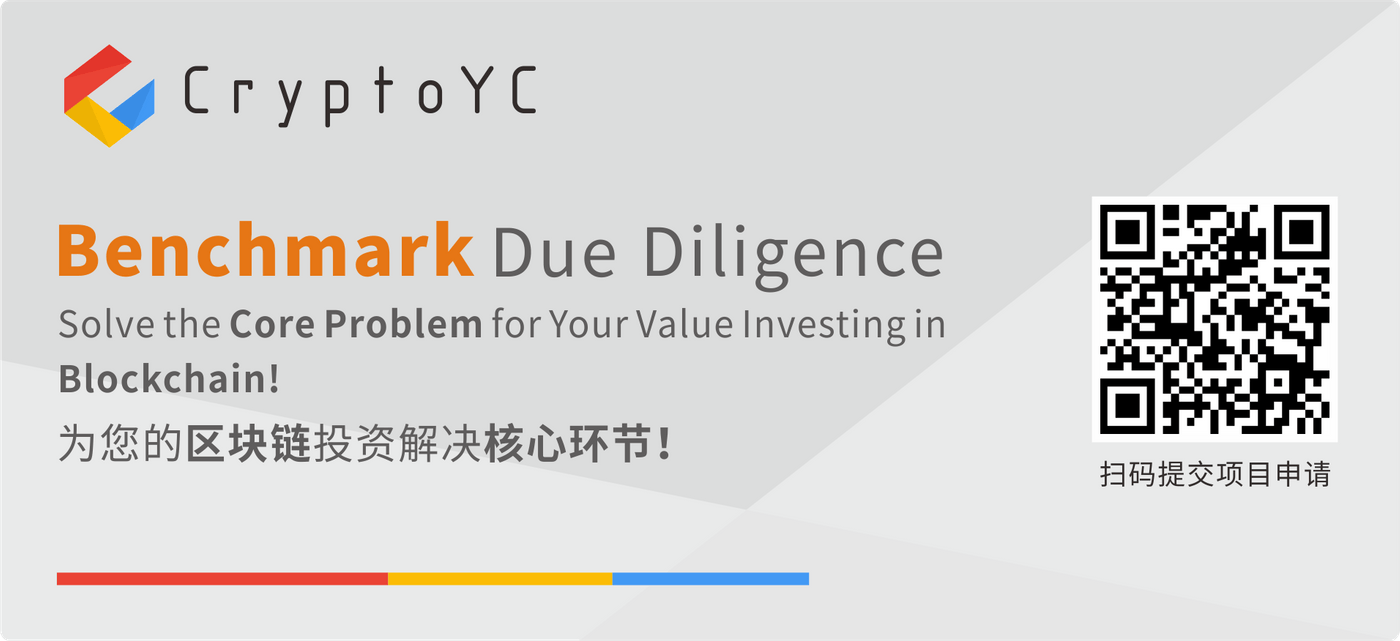
创造
CryptoYC Benchmark丨 Blockchain Technical Due Diligence

CryptoYC is a blockchain investment and incubation company . We developed CryptoYC Benchmark to carry out Technical Due Diligence against Blockchain projects and also provide Blockchian business consulting services for institutions and investors.
Benchmark is the world’s first blockchain technology due diligence system.It focus directly on projects’technology and test various tech standards from multiple dimensions,and commit due diligence for Blockchain projects based on objective and unbiased data.Contribute to health development of the industry.
Now!We decide to released Benchmark simplified version, technical due diligence, for who need it.Benchmark due diligence(Simplified Version) was made by CryptoYCTech to help investors learn the transparency of a blockchain project in terms of technical conditions, and conduct technical investigation from the aspects of consensus mechanism, code, security and scalability, so as to let more people understand the real performance of the project.
There are many institutions in the market providing due diligence reports of the project, including large institutions such as Binance whose report is also very rich in content.
Therefore, as there are such kind of due diligence reports in the market, why do we make this due diligence report? What is the difference between our due diligence report and others?
We think, in the current market, individual’s understanding of projects is limited. People count on the support from those giants whom they are familiar with, or get a glimpse of the project superficially based on hearsay. Few people really understand a project in an in-depth way, neither the channels or methods of a project, nor the white papers. Besides, it is difficult for ordinary people to understand these technical articles. Therefore, investor do not really understand a project, which often leads to inaccurate judgment of the project. For investors, if they don’t know or care about the projects they invest in, then this will be a lesson that needs to be paid for.
With this in mind, we decided to make a technical due diligence report Benchmark. By technical testing and data collection, we made a short report which can make it easier and more intuitive for people to understand a project.
Compared to other test reports in the market, Benchmark builds its own public chain testnet to simulate transactions and various security attacks and this report focuses on autonomy and technology.
We built our own public chain testnet to test the discrepancies in the technology of project, and then asked our technical staff to analyze, collect data, and finally generate a due diligence report.
The testing process of Benchmark is as follows:
Step 1: After the project proposes request of test, according to the project’s Github code and white paper, the team will first build a public chain testnet;
Step 2: The team simulates transactions and various security attacks;
Step 3: The team applies the testnet to detect various parameters of the code, such as security, originality, etc.
Step 4: Professional technicians of the team analyze the degree of implementation of the white paper and the actual technology, collect data, and finally complete a transparency analysis report reflecting the authenticity of the project from a technical perspective.
In the report, the specific contents tested mainly include:
First, consensus mechanism. For example, what is the consensus algorithm for the project? Has this consensus algorithm been implemented?
Second, code. For example, what is the impact of the code? How similar is it to other project code? Are there problems such as plagiarism?
Third, security. For example, Benchmark provides test results after analog attacks including the ability to withstand Sybil attacks, long range attacks, short range attacks, Dos attacks, overflow attacks, BGP hijacking attacks, network splitting attacks and so on. In conclusion, the safety of the project should be examined from multiple perspectives.
Fourth, scalability. For example, what kind of extension scheme is adopted by the project, namely, sharding or sidechain, and whether the extension scheme has been implemented or not is identified from the source code.
Fifth, system performance. For example, what is the TPS that people care about most.
Sixth, token incentive model. For example, the team will analyze the token model mentioned in the white paper and involved in the actual implementation process of the project, and examine the economic model, implementation bottleneck and other aspects.
Seventh, the development of Dapp. As it is known that one of the key ways to capture value for a public chain is to have more and more Dapp users on it. Therefore, the quantity, quality and market share of Dapp development will also be shown in the report.
Eighth, make an overall evaluation according to the previous seven aspects. For example, what are the advantages and disadvantages of the public chain technology? What is the operating limit of the public chain? What is the possible development path of the public chain in the future?
The above are the testing process and the content of this Benchmark report.
Some investors may wonder whether this report mainly composed with technical data is understandable for non-technical people, given all the technical terms and techniques.
In fact, you can completely ignore this concern, because even non-technical personnel also can completely understand this report.
First of all, this report is simple and easy to understand. We describe each technical point in plain language that non-technical personnel can understand, so that investors who do not understand technology can learn the advantages and problems of this project.
Secondly, Benchmark focuses on the analysis of technical indicators and only focuses on the hard power of technology. A report is kept in no more than 2000 words which can be read off in 5–10 minutes instead of being filled with harangue that make readers lose their patience in reading it.
Finally, with our own testing tools and technical team, and as a third party, we evaluated based on the technology as evaluation criteria, so there is no fraudulent data or favoritism towards any project side. Instead, it will present the way the project side tried to give pie in the sky (fake blueprint) in the form of data, which more fairly reflects the authenticity of a project.
This is our Benchmark test report, which is not perfect, but we will continue to collect feedback from the market and keep iterating. Our goal is to provide the most authoritative test report in the market. Please stay tuned to the next version.
Catch with CryptoYC: Twitter, Telegram, Github,Weibo

喜欢我的文章吗?
别忘了给点支持与赞赏,让我知道创作的路上有你陪伴。
发布评论…